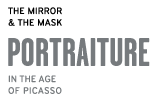
A Portrait of Society
This section looks at the different ways of approaching the portrait during the inter-war period, in which the traditional vision of a specific, unique person was called into question as a result of various factors that led to the perception of the individual as a social reality. The so-called “return to order” involved the revival of a realistic depiction of the sitter, from Picasso’s classical vision in his various portraits of Olga and those of other artists such as Jacques Lipchitz and Salvador Dalí, to the realism of the German artists (such as Otto Dix, Christian Schad, George Grosz and Max Beckmann) and on to portraits by Balthus, Lucian Freud and Stanley Spencer. The realist aesthetic was no longer, however, considered sufficient to represent a particular individual and this new realism concealed a certain degree of deceit, a distorting element that could be as subversive as the most radical avant-garde art.
This section looks at the different ways of approaching the portrait during the inter-war period, in which the traditional vision of a specific, unique person was called into question as a result of various factors that led to the perception of the individual as a social reality. The so-called “return to order” involved the revival of a realistic depiction of the sitter, from Picasso’s classical vision in his various portraits of Olga and those of other artists such as Jacques Lipchitz and Salvador Dalí, to the realism of the German artists (such as Otto Dix, Christian Schad, George Grosz and Max Beckmann) and on to portraits by Balthus, Lucian Freud and Stanley Spencer. The realist aesthetic was no longer, however, considered sufficient to represent a particular individual and this new realism concealed a certain degree of deceit, a distorting element that could be as subversive as the most radical avant-garde art.

Pablo Picasso
Olga with a Fur Collar, 1923
Oil on canvas, 45 5/8 x 31 5/8 in. (116 x 80.5 cm)
Musée Picasso, Paris. On deposit at the Musée des Beaux-Arts, Lille

Max Beckmann
Quappi in a Pink Sweater, 1935
Oil on canvas, 41 3/8 x 28 3/4 in. (105 x 73 cm)
Museo Thyssen-Bornemisza, Madrid

Lucian Freud
Girl with Roses, 1947-1948
Oil on canvas, 41 3/4 x 29 3/4 in. (106 x 75.6 cm)
British Council, Londres

















